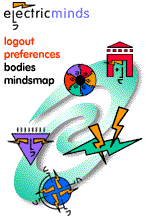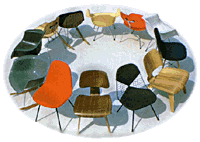
|

|

Charles and Ray Eames One danger of continually trying to look at the big picture, as we here at Technos Central strive for, is that it's easy to overlook individual contributions. There's a lot to be said for looking at the planet as an ecology, history as a series of cycles, and the human race as an interlocking system of cultures. But in doing so we risk looking at the world from so distant a vantage point that we can't see the specific people who have made what we're looking at. Further complicating the matter are the individuals whose contributions are so numerous and wide-ranging that it is hard to recognize what they've wrought as having come from a single source. I am writing now about Charles and Ray Eames.
 © Eames Office 1989, 1997 The subtitle to Pat Kirkham's recent biography of the couple is The Designers of the Twentieth Century. This is no exaggeration. Here is a highly abbreviated sampling of the Eames Studio's creative output:
 © Eames Office 1989, 1997 It is difficult to overstate the impact of the Eameses' work. If you attended school, waited for a plane, or ate in a restaurant between 1960 and 1990 you have very probably spent hours in a chair they designed. The products they designed were - and still are - inexpensive to manufacture and maintain and at the same time are comfortable, attractive, and useful. Their museum displays, multimedia presentations, and films were enormously influential. The Eameses more or less invented multimedia as we have come to recognize it. Common elements of the vocabulary of television - stills dissolving into stills, extreme close-ups, stop-motion animation, and multiple images in the service of educating and presenting information - are all techniques that made their first appearance in the Eameses' films thirty or forty years ago. The Eameses' approach to design grew out of the sober commitment to functionality and industrial mass-production that marked prewar modernism. What they added was an enthusiasm for life not found in the airless worlds of the Bauhaus. (In the short film Design Q&A, Charles responds to the question "Is design able to cooperate in the creation of works reserved solely for pleasure?" by asking, drily, "Who would say that pleasure is not useful?") . Their visual imagination was generous, vivid, and clear. And Charles and Ray Eames recognized that presenting detailed information to a general audience was an opportunity to make art of the highest kind. All very interesting. But why talk about them here?
 © Eames Office 1989, 1997 Never before or since have artists so wholeheartedly embraced industrial capitalism as the Eameses did. They began making their fortune during the Second World War, when they developed new industrial processes for molding plywood and used those processes to produce splints and litters for the Army. After the war, they turned these new processes (and other new technologies that emerged from the war, such as the molding of fiberglass) to the task of making inexpensive furniture of a quality not previously available to the general public. As their careers progressed, their most prominent design projects were accomplished with the cooperation and funding of major corporations like IBM, Alcoa, Polaroid , and Westinghouse. They were, in short, up to their eyeballs in what we used to call the military-industrial complex. At the same time, what they made was incontestably wonderful. I've never met anyone who saw the film Powers of Ten or the wild kinetic sculptures of the Mathematica exhibit and didn't find them astonishing and delightful. It's hard to sit in an Eames Lounge Chair and not hunger for it. (Save your pennies; Herman Miller still makes them, at about $3500 a pop.) And if Charles had troubled himself to exhibit his photographs as fine art, rather than incorporating them into the Eames Studio's larger works, he would certainly be recognized as one of the century's finest photographers. Their work also contains a kind of optimism that once came to us more easily than it does today. A search for meaning and beauty lies at the core of the human experience. These days we tend to assume that the workings of industry, commerce, and technology are inimical to this search. The Eameses, on the other hand, dedicated their lives to the exact opposite. They bent industry, commerce, and technology to the task of improving the lives of ordinary people, making it easier for them to derive meaning for their lives and fill their own worlds with beauty. And they did this very, very successfully. It would do us well to pay attention to the Eameses' optimism, and to bear it in mind as we turn a critical eye to the technological world we now inhabit. As Jon Carroll once put it, "Things are indeed terrible all over. This is a known fact. What is not generally acknowledged is that things are also not terrible all over."
|
rlauriston said: I narrowly avoided a car crash once--saw a truck losing control, floored the engine, looked in the rearview, and saw the truck jack-knifed across all four lanes of Interstate 80, and cars smashed up every which way. I think maybe that was when I refused to ride in cars for a couple of years. In any case it was much more disturbing than any of the three relatively minor crashes I was actually in myself. But it didn't make me horny--maybe that's because Rosanna Arquette wasn't along for the ride. Most Active Topics: Topic 108 Sites - Feedback from visitors Topic 98 C-Topia Zeit and Nancy Swim the Channel Topic 101 C-topia Prepping for Utne | |||
| ||||
Also in Technos: The Technology of Surgery Our New Cathedral Beethoven's Fifth Symphony | ||||
|
electric minds |
virtual community center |
world wide jam |
edge tech |
tomorrow |
conversations
Any questions? We have answers.
©1996, 1997 electric minds, all rights reserved worldwide.
|

